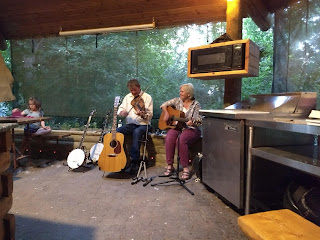We had read that just south of where we are staying there are a few unusual scenic places: Cedar Bluff State Park, Threshing Machine Canyon, and the Castle Rock Badlands. The latter 2 were on a list of 8 Kansas Wonders. That sounded good to us!
Following Google directions, we headed south in the Elantra, away from the Interstate. A 2-lane 65 mph road led due south like an arrow shooting through Kansas farmland. We passed a picturesque church, the only building on the road, and shortly realized that we should have turned at the church to head to the Badlands. This was route 458, otherwise known as local R road, known elsewhere as an
 |
| S Road (I think) |
"unimproved road". We did hope that it would eventually change to pavement. No such luck. After 20 miles of right and left turns, passing at least 4 snakes (2 of them very large) crossing the road, many washboard areas, acres and acres of corn and sorghum, no houses or buildings, people or cars, a few pieces of farm equipment, and some cattle, we made the turn for Castle Rock. As we approached the area, Google directed us to take a right turn. Ahh, no. I guess there
used to be a road there. A rocky, cavernous, axle-destroying path is what was left. So we figured we would take the other road (loosely describing the other fork) as far as we could go--which turned out to be about 50-75 yards. That road was so badly rutted that we didn't dare try advancing through it. It would take AAA more than a couple of hours to get to us there. So we just stopped, and started to explore the rock formations that were within walking distance. It was a beautiful area, with views across the landscape, carpeted with wildflowers, with not a soul around. All we could hear was the buzz of cicadas. I joked to Ray that if we met our demise here, our bodies would never be found. It looked like we may have been the only visitors here in quite a while.
After the Castle Rock Badlands, next on the agenda was Cedar Bluff State Park. Again, dirt roads, farms, corn, sorghum, no houses or people, etc, etc. We arrived and went to the park office to be directed to Threshing Machine Canyon, which was supposedly nearby. The Kansas tourism office had instructed us to inquire there for directions. The young girl at the desk (the only person there) had never heard of it. Threshing Machine Canyon is the site of an 1850s Native American attack on a wagon train bearing a threshing machine, where there are carvings in the rocks dating back to the mid-1800s. At any rate, with no one else to ask, we tries to figure out where it was. We found a trail
 |
| A bench to enjoy the view of the reservoir: once they cut the pine trees |
in the park that ran along the reservoir and into the prairie and took that, and discovered that the section of the park with the bluffs was several miles away on the trail. In search of the Threshing Machine canyon, it seemed that there were no clear directions online, and no one seemed to know where it was.
Kansas really needs to get its tourism act together. No signs, and people who should be there with answers have no clue.
But it is a beautiful state with farms, prairie, wildflowers and sky that goes on forever. Pictures are here:
https://photos.app.goo.gl/CqVbwRUkbirDMGaw9
















































